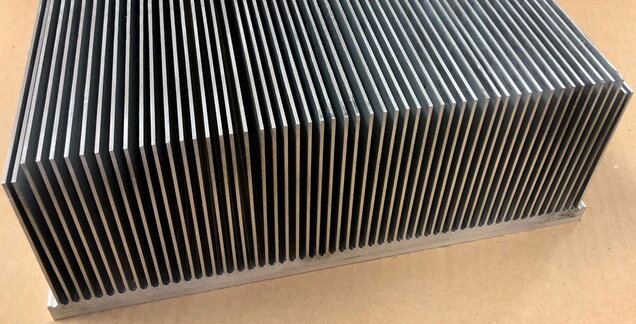Bonded Fin Heat Sinks
Bonded fins technique is a conventional high power large heat sink manufacturing technique. Bonded fin heat sink may have the bad phenomenon of loose heat sink fins, especially with thick heat sink fins, which will loose or even fall off at a higher rate. The features of bonded fin heat sinks include more fins per inch, smaller fin gap, and flexible profile height and width so that they are suitable for different sizes of application space. This kind of heat sink is small in size and light in weight, so it is an ideal choice for cooling high power equipment.
In the high power applications where significant heat is generated in a small volume, bonded fin heat sink designs can meet the packaging needs by increasing the heatsink surface area without increasing volume, reducing thermal resistance by 50% to 66%. Bonding fin heat sink removes the design limiting fin extrusion ratio found in extruded heat sink. Typical extrusion heat sink fin ratios range from 4:1 up to a maximum 16:1; while bonded fin heat sink designs allow ratios up to 44:1 or greater, providing cooling in forced convection for some high power applications. Bonded fins, fabricated from aluminum sheet through extrusion, are bonded to the machined and grooved base with a highly conductive thermal resin.
Bonded fin heat sink features as the following:
- Higher aspect ratio and high fin density of fins increase cooling surface area so the heat sink with high performance.
- Lower thermal resistance for the high power device heat dissipation.
- Aluminum fin, copper base, aluminum base can be assembled into bonded fin assemblies.
- Fins fabricated from sheet metal or extrusion, custom designs available, the metal plate is made of fins, which can be cut to a specific size.
- We can customize your wings according to thermal performance requirements and packaging size height restrictions. For more complex designs, we can extrude fins to specific shapes and lengths.
- Used for high power forced convection cooling applications.
- Bonding resin with highly thermal conductive for minimal thermal loss.
- Dissipate more heat than the conventional heat sinks with the same footprint.
- Reduce heat sink and overall system volume
- Increase the aluminum cooling surface area by two to three times than traditional heat sink

Bonded fins
Bonded fins are a good high power solution for either natural or forced convection. Individual straight fins are cut and bonded into a grooved base plate. The fins are usually thicker than you would find on a zipper/skived or folded fin, so they have the capacity to be more efficient, even at tall heights. Aluminum and copper fins can be combined on the same heat sink to provide improved performance without all of the weight gain. If weight is especially important, graphite fins can also be used, but they are more delicate so extra care must be taken.
In some applications it is helpful to have devices mounted to both the top and bottom of a heat sink with a fin structure in between for compactness. While this can be accomplished using a sandwich bonded fin, another method is the stack fin heat sink. An individual fin is extruded so that it looks like an “I”. There are interlocking features in both top and bottom bases. A series of the fins are stacked side by side and compressed together to form a heat sink. The top and bottom surface of each base is machined to ensure a flat mounting surface and then any secondary features are added. Depending upon the construction of the interlocking features, thermal epoxy can be used between the sections to improve the performance
Bonded fin heat sinks are generally geared towards physically large applications that require moderate performance. Bonded fin heat sinks are made by bonding individual fins of metal to a base. The bonding can be done by a thermal epoxy (somewhat cost-effective) or by brazing (expensive). The main advantage to this type of heat sink is it can be used for large applications, such as a DC-DC Brick, or an electric welder. The main drawback is manufacturing process isn’t automated on the scale of stamped, extruded, or folded fin heat sinks, resulting in a high cost for bonded fin.